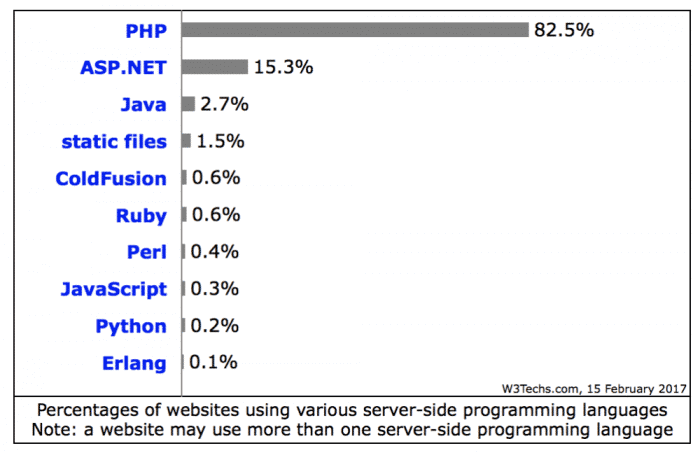Website applications have gained tons of momentum over the past few years and more and more people are wanting to expand the functionality of their websites. Server-side languages and frameworks are a great way to allow your website to become more than just images and text. PHP has solidified itself as one of the most popular web languages. However, Ruby on Rails has continued to be a part of the ever-growing web.
PHP and Ruby on Rails have become two very popular solutions to these new requirements that the web now requires. These server-side languages and frameworks allow websites to receive information from their users and supply them with the information they desire.
PHP and Ruby on Rails comparison
The Languages
PHP is one of the most commonly used server-side languages used on the web today. According to a great study published on the usage of top programming languages in websites, 82.5% of websites whose server-side languages are known are using PHP. Many of the most common websites, including Facebook and WordPress, are using PHP inside their websites.
Ruby on Rails, commonly known only as Rails, is a popular web framework written on top of the Ruby programming language. Reports by W3tech.com shows that 0.6% of websites whose server language is known uses Ruby on Rails.
PHP, Why it’s Awesome
A PHP website can be written in just a matter of minutes due to its familiar syntax to many. Adding the following element tag to a PHP file will result in the very familiar “hello world” being displayed on the user’s screen:
<?php echo”hello world!” ?>PHP also allows for HTML to be used alongside the PHP code in a file. However, this is considered bad practice by many and should be avoided if possible. PHP does have features built in to allow for including HTML with your PHP by using the “include” element.
PHP itself is a programming language, which means that many web frameworks have been written on top of it in order to help with the common issues server-side languages face. PHP also has a very large community of developers. A strong community is not only great because there are thousands of people that can help you out, but also thousands that have experienced the same issues as you.
PHP has continued to develop as a language with each new version. With the introduction of PHP 5, the PHP Data Object was introduced. The PDO allows for easier connections to common database types. PHP 5 also introduced json_encode which makes representing a set of data as JSON, javascript object notation, much easier.
And Why It’s Not
Model-View-Controller, commonly known as MVC, is a popular programming design pattern used by people in all practices of programming. Because PHP is loosely mandated, source code files can be designed in multiple ways that can produce the same correct result. This creates an unoptimized workflow due to the sometimes drastic differences programmer’s styles can be.
MVC helps to reduce these normally different coding styles and attempts to, at least to some extent, reduce the vast gaps of styling. PHP does not natively support the MVC pattern but can be implemented with some effort or by using a PHP based framework.
What are these Rails?
Ruby on Rails is one of the fastest-growing web frameworks around primarily due to its ability to create products at a high rate. Rails can be set up and ran with just a few lines of code. Because it’s also a framework and not a language, Rails has many built-in features that make programming a web service much quicker than a standard language. For example, a complete MVC structure can be created in rails with a simple command-line instruction similar to the one below
rails g scaffold User name:string address:stringThis line of code generates all three aspects of the MVC; the model responsible for connecting to the database, the views to distribute what the user will see as well the controllers to connect the two pieces mentioned before together.
While this not only creates all the parts needed, Rails also provides what is commonly known as separation of concerns. This is done by keeping all aspects related to the database in the model and all aspects of the views kept inside the template files. The controller is in charge of communication between the two. With the separation, bugs can be more easily identified and can result in quick fixes.
Another benefit many developers enjoy is the built-in database support Rails provides. While PHP, as all others do, gives the ability to access data stored inside a database, Rails provides an experience where querying language knowledge can be used but can be done without. Using a method like the one below, a user can get all of the data stored inside a table called “users”.
User.allThat’s all! And if you want only certain columns inside the table, this can be done with just a small tweak
User.select(‘name’,’address’).allBecause of the quickness of getting a product up and running many developers have begun to use Rails in small projects, with a number beginning to use it now for larger ones as well.
So What is the Catch?
While Rails does have many of the great features developers desire, it does have issues that come along with it. One of the common issues expressed by critics of Rails is the need to know the MVC pattern. While there may be a learning curve to understand how Rails works, this is no different than needing to learn SQL in order to use PHP.
Another common point brought out is that Rails performs at a much slower speed, sometimes performing 1/100th of the request per second PHP can. While this may be true, PHP is also its own language so speed measurements will tend to favor it.
So Which do I Use: PHP or Ruby on Rails?
If speed alone is your highest priority, PHP is the way to go. PHP can execute long-running commands at a high rate and will have a little hiccup to it. This programming language is also good for developers who are looking for a large number of community users that can help provide solutions to their issues.
Compared to Ruby on Rails, PHP is better in terms of performance and you can build a super fast website using it.
If you are looking for something that can allow you to get up and running quickly and provides its own structure so that coding conventions are better followed go with Rails. It’s a great framework that with a little time, you can learn quickly and can lead to a quicker turnaround in projects.
Websites are becoming more and more involved with users each and every day. These same websites have the responsibility to provide the best possible experience for anyone that uses them. That is why dedicated languages and frameworks are created to help aid in the development of such sites. Whether you are building a quick and simple website that you use Rails on, or create a highly sophisticated web app using PHP, your site can be amazing.

